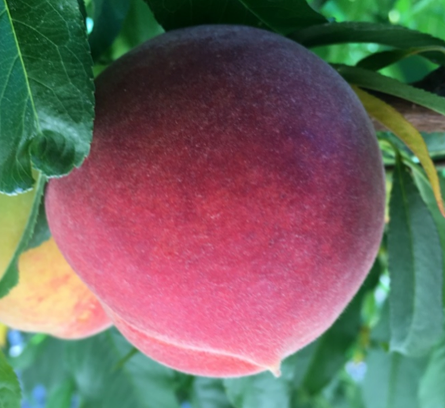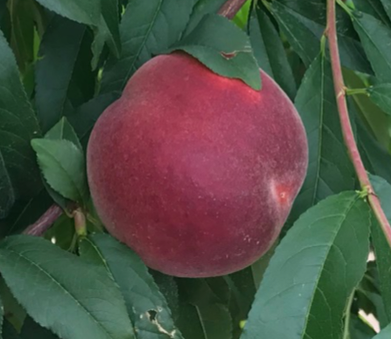Crop Production

Peach growers in Alabama are looking for competitive new cultivars to solve various production issues and improve production sustainably. The Clemson University peach breeding program is developing new improved peach selections that can considerably contribute to production sustainability. Several of these selections, including SC-1 and SC-2, are reported to possess multiple valuable traits, including fruit tolerance to bacterial spot.
Trees from SC-1 and SC-2 selections were introduced to Alabama and planted at the Chilton Regional Research and Extension Center near Clanton in 2017. This research looked to evaluate these new hybrids’ vegetative growth, phenological development, cropping potential, and fruit quality attributes in central Alabama growing conditions.
2021 Data
The first commercial crop for both selections was harvested in 2021. Data was collected to compare their season of ripening and determine overall tree performance. During early spring of 2021, the extremely low temperatures in mid-February caused a significant amount of damage to developing peach buds in central Alabama. It was observed that early varieties had 35% bud survivability, while mid- and late-season cultivars had 28% and 22% survivability respectively. In comparison, early season SC-1 trees had 7% live buds, which resulted in a relatively poor cropping this season. In contrast, the SC-2 selection had 80% live buds and produced an excellent crop in 2021.
SC-1 Data

Figure 1. Bacterial spot-tolerant SC-1 peach selection grown at the Chilton Regional Research & Extension Center.
The fruit of SC-1 started to mature in the second part of May, and the trees were harvested May 28, June 1, June 4, June 8, and June 11. (table 1). The fruit appearance is attractive with almost 100% blush cover and slightly elongated fruit shape compared to the SC-2 selection (figure 1).
The average yield per tree of SC-1 was 29.4 pounds. The highest crop average of 10.8 pounds per tree was recored at the June 4 harvest, when the average number of fruit harvested per tree was also the highest. The mean fruit size varied between 195 and 207 grams among the harvest dates, averaging 200.6 grams for the season. Eating quality was good as the fruit had juicy, firm flesh. The average sugar content of 10.7% indicates fruit was harvested a bit early this year due to the frequent rain events.
Table 1. Yield and Fruit Quality of SC-1 Peach Selection
| Harvest Date | Average Number of Fruit per Tree | Average Yield (pounds) | Mean Fruit Weight (grams) | Soluble Solid Content (%) |
|---|---|---|---|---|
| May 28 | 11.4 | 5.1 | 197 | 10.8 |
| June 1 | 21.4 | 8.4 | 199 | 11.5 |
| June 4 | 25.0 | 10.8 | 207 | 11.0 |
| June 8 | 8.0 | 3.1 | 205 | 10.3 |
| June 11 | 4.3 | 2.0 | 195 | 9.8 |
| Season Total | 14.2 | 29.4 | 200.6 | 10.7 |
SC-2 Data

Figure 2. Bacterial spot-tolerant SC-2 peach selection grown at the Chilton Regional Research & Extension Center.
Fruit of SC-2 started to mature in mid-May, and the trees were harvested May 17, May 21, and May 25 (table 2). The fruit appearance is attractive with almost 100% blush cover and nicely rounded fruit shape (figure 2).
The average yield per tree was 84.3 pounds, with the highest crop average of 55.4 pounds being harvested May 25. The mean fruit size varied between 128.6 and 144.4 grams among harvest dates, averaging 137.3 grams for the season. Eating quality was good as the fruit had juicy, firm flesh. Soluble sugar content averaged 10.4% which indicates fruit was harvested a bit early this year.
Table 2. Yield and Fruit Quality of SC-2 Peach Selection
| Harvest Date | Average Number of Fruit per Tree | Average Yield (pounds) | Mean Fruit Weight (grams) | Soluble Solid Content (%) |
|---|---|---|---|---|
| May 17 | 45 | 11 | 128.6 | 9.9 |
| May 21 | 60 | 17.8 | 144.4 | 10.6 |
| May 25 | 232 | 55.4 | 139.0 | 10.6 |
| Season Total | 337 | 84.3 | 137.3 | 10.4 |
Conclusion
High pack out volume, size consistency, and an attractive appearance are excellent fruit quality attributes for both selections. Although a heavy bacterial spot infection was recorded during 2021 in Southeastern peach orchards, both selections demonstrated high fruit tolerance to this economically important bacterial disease.
